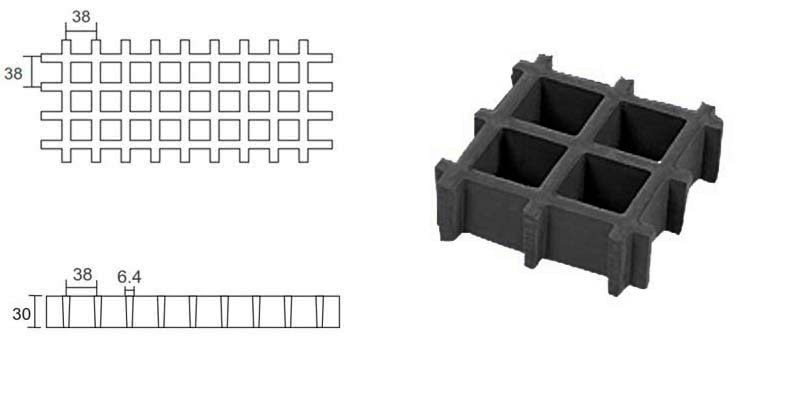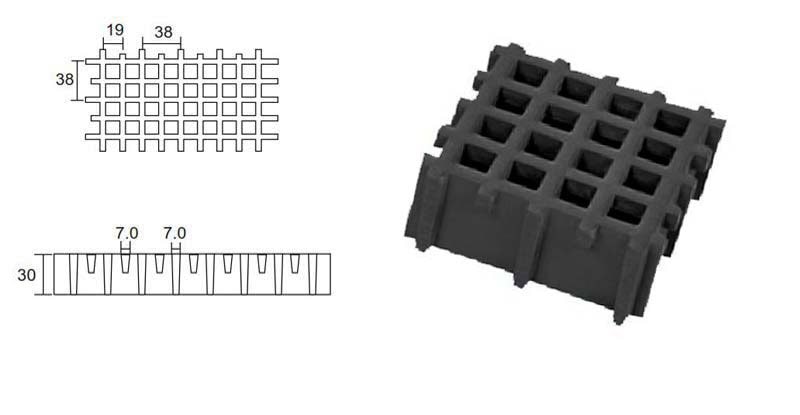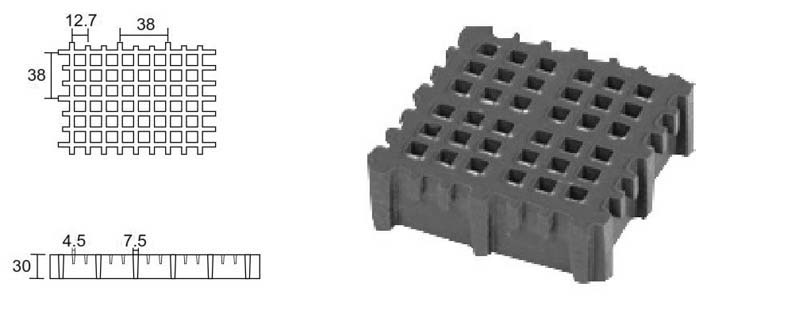FRP Grating

MacroMesh
Our MacroMesh FRP grating has 1 ½” x 1 ½” primary load bars giving an aperture size of 1 ¼” x 1 ¼”.
MacroMesh grating is typically used where there are no concerns about small objects falling through the mesh and the panels will not be subject to small wheeled traffic. Normally MacroMesh grates are supplied with the factory default concave surface finish on the top of the load bars but a gritted finish can be supplied where extra slip resistance is required.
MacroMesh grates are commonly used for roof access walkways, industrial platforms and marinas.
| Primary grid bars | 1 ½” x 1 ½” (on center) |
| Aperture | 1 ¼” x 1 ¼” |
| Load bar thickness | ¼” |
| Open space | 68% |
| Std. panel thickness | 1 1/4” |
| Panel size | 4′ x 8′ |
| Weight | 2.5 lb/sq.ft. |
| Color (std.) | dark grey (other colors on request) |

MidiMesh
Our MidiMesh FRP grating has 1 ½” x 1 ½” primary load bars with an extra intermediate cross bar at the top of the grating, ½” deep creating a ½” x ½” aperture. The smaller apertures provide good water drainage and airflow, prevent objects from falling through and provide a surface more suitable for small children, pets, prams, cyclists, wheelchairs, and other small wheeled traffic.
MidiMesh grating panels are typically preferred for elevated public walkways, especially in parks and reserves, as well as pedestrian access decking on docks, piers, boat lifts, pontoons and jetties. The panels are also useful around pools, waterparks and other general recreational areas.
MidiMesh is typically supplied with a bonded grit surface to prevent slippage during wet or icy conditions, thus allowing all year usage of pedestrian walkways and other elevated access paths. However for beach access applications, grit surfaced FRP can be harsh on bare feet. For greater comfort, MidiMesh with a meniscus surface could be considered which still provides good degree of ant-slip properties.
| Primary grid bars | 1 ½ x 1 ½” (on center) |
| Secondary grid bars | ¾” x ¾” (on center) |
| Aperture | ½” x ½” |
| Load bar thickness | ¼” (primary), ¼” (secondary) |
| Open space | 42% |
| Std. panel thickness | 1 ¼” |
| Panel size | 4′ x 8′ |
| Weight | 3.5 lb/sq.ft |
| Color (std.) | dark grey (other colors on request) |

MiniMesh
Our MiniMesh FRP grating has 1 ½” x 1 ½” primary load bars with two extra intermediate crossbars at the top of the grating, ½” deep, creating apertures of just ¼” x ¼”. The small apertures prevent most objects from falling through but still offers good drainage.
MiniMesh is recommended for ‘pedestrian-friendly’ walkways frequented by pet walkers, strollers, carts, other small wheeled vehicles and especially high heel shoe wearers. For elevated turf applications, the small aperture size creates a smooth, strong surface that still allows water to drain efficiently.
MiniMesh decking is typically used on docks, piers, boat lifts, pontoons, jetties and decks. It is also used in and around pools, marinas, waterparks and other public recreational areas.
| Primary grid bars | 1 ½” x 1 ½” (on center) |
| Secondary grid bars | ½” x ½” (on center) |
| Aperture | ¼” x ¼” |
| Load bar thickness | ¼” (primary), 3/16” (secondary) |
| Open space | 30% |
| Panel thickness | 1 ¼” |
| Panel size | 4′ x 8′ |
| Weight | 4.5 lb/sq.ft. |
| Color (std.) | dark grey (other colors on request) |
Panel dimensions may vary by up to 1/8″. Allowances should be made for this manufacturing tolerance when constructing frames to contain panels.
Archatrak has specifically selected FRP resins, fillers and additives designed for maximum outdoor durability and fire resistance of our grating panels. Only Type-I resins combined with Aluminum Hydroxide filler (not Calcium Carbonate) can provide the fire retardant and smoke suppression properties necessary for most exterior boardwalk and marine deck applications.
Type-O – polyester resin system with mid-level chemical resistance. Typically used in commercial or light industrial applications, especially where moisture is prevalent.
Type-I – isophthalic resin system. Archatrak’s standard and the most popular resin system for more demanding industrial, marine and boardwalk grating applications. Provides long-lasting performance in areas where corrosion is an issue.
Type-V – vinyl ester resin system. Provides the highest chemical resistance and typically used in environments where FRP products are subject to frequent and direct contact with the harshest of chemicals.
Type-P – phenolic resin system. Used where fire resistance, low flame spread index, smoke suppression and low toxic fumes are critical. Typically used in offshore applications and confined spaces.
Typically, FRP grating will be rated in accordance with ASTM-E 84 as non-combustible with a flame and smoke spread level significantly less than 25. UV absorbers such as UV9 must also be incorporated into the resin system for long-term UV protection.
Gritted – Quartz grit is bonded to the top surface of the grid, to provide an exceptionally safe and hard-wearing walking surface with excellent slip resistance in wet, oily and icy conditions. Typically achieves a rating of R13 for wet/oil ramp and P5 for Wet Pendulum.
Concave – This standard post-production finish is created during the curing process when the top surface of the FRP grating naturally shrinks back to create the concave effect. This surface is typically used in applications where a degree of slip resistance is required for wet conditions, but a gritted surface may be too harsh (for example beach access boardwalks).
Smooth – The concave post-production finish is sanded to a flat surface and then coated with resin. This surface is best used in architectural applications where a flat and regular surface appearance is desired.
Conductive – Our standard range of FRP gratings are all non-conductive. However, there are occasions when conductive gratings are required. For these gratings, a top surface of a carbon based material is applied which is highly conductive. Copper earthing straps are then fixed at intervals to the grating and grounded, to safely discharge any static electricity.
FRP grating panels are exceptionally quick and easy to install, normally just requiring fixing to bearers with special stainless steel fiberglass grating clips which are also used to tie panels together.
Safety procedures when cutting and handling fiberglass grating and guidelines for installing fiberglass panels in dock decking and boardwalk applications, can be seen here.
Downloads
 Archatrak FRP Grating MiniMesh - CAD drawings
Filesize: 257905b
Archatrak FRP Grating MiniMesh - CAD drawings
Filesize: 257905b
 Archatrak FRP Grating MidiMesh - CAD drawings
Filesize: 235605b
Archatrak FRP Grating MidiMesh - CAD drawings
Filesize: 235605b
 Archatrak FRP Grating MacroMesh - CAD drawings
Filesize: 223883b
Archatrak FRP Grating MacroMesh - CAD drawings
Filesize: 223883b
 Archatrak FRP Grating Fire Test ASTM E84
Filesize: 1643114b
Archatrak FRP Grating Fire Test ASTM E84
Filesize: 1643114b
 Archatrak FRP Grating Deflection Chart
Filesize: 2336182b
Archatrak FRP Grating Deflection Chart
Filesize: 2336182b







